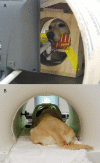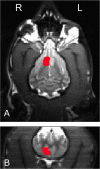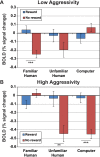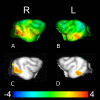One pair of hands is not like another: caudate BOLD response in dogs depends on signal source and canine temperament - PubMed (original) (raw)
One pair of hands is not like another: caudate BOLD response in dogs depends on signal source and canine temperament
Peter F Cook et al. PeerJ. 2014.
Abstract
Having previously used functional MRI to map the response to a reward signal in the ventral caudate in awake unrestrained dogs, here we examined the importance of signal source to canine caudate activation. Hand signals representing either incipient reward or no reward were presented by a familiar human (each dog's respective handler), an unfamiliar human, and via illustrated images of hands on a computer screen to 13 dogs undergoing voluntary fMRI. All dogs had received extensive training with the reward and no-reward signals from their handlers and with the computer images and had minimal exposure to the signals from strangers. All dogs showed differentially higher BOLD response in the ventral caudate to the reward versus no reward signals, and there was a robust effect at the group level. Further, differential response to the signal source had a highly significant interaction with a dog's general aggressivity as measured by the C-BARQ canine personality assessment. Dogs with greater aggressivity showed a higher differential response to the reward signal versus no-reward signal presented by the unfamiliar human and computer, while dogs with lower aggressivity showed a higher differential response to the reward signal versus no-reward signal from their handler. This suggests that specific facets of canine temperament bear more strongly on the perceived reward value of relevant communication signals than does reinforcement history, as each of the dogs were reinforced similarly for each signal, regardless of the source (familiar human, unfamiliar human, or computer). A group-level psychophysiological interaction (PPI) connectivity analysis showed increased functional coupling between the caudate and a region of cortex associated with visual discrimination and learning on reward versus no-reward trials. Our findings emphasize the sensitivity of the domestic dog to human social interaction, and may have other implications and applications pertinent to the training and assessment of working and pet dogs.
Keywords: Animal temperament; Canine cognition; Caudate; Comparative neuroscience; Neuroimaging; Reward systems; fMRI.
Figures
Figure 1. The computer reward (A) and no-reward (B) signals.
Figure 2. (A) Participant Kady stationed in the mock scanner with the treat kabob. (B) Participant Zen stationed in the MRI bore, facing the projection screen (and wearing ear protection).
Figure 3. The right caudate seed, anatomically defined, used for participant Kady, in the transverse (A) and coronal (B) planes.
Figure 4. Whole-brain group analysis of response to all reward–no-reward conditions.
An unthresholded transverse slice (A) and coronal slice (B) are shown, as is a coronal slice thresholded at 0.005 (C). Color indicates _t_-statistic at each voxel against the null hypothesis of equal activity to reward and no-reward conditions. Significantly greater activity was observed in the reward versus no-reward condition.
Figure 5. Activation within caudate ROIs in dogs with low and high aggressivity (relative to our sample mean) for reward and no-reward signals across the three source conditions.
Values and s.e. are derived from the full mixed-effects model, using Z-scores for C-BARQ factor 1 of + 1 for dogs with higher aggressivity and −1 for dogs with lower aggressivity (±1 corresponded to the upper and lower limits of the scores). Dogs with lower aggressivity showed significantly greater caudate activation to reward versus no reward signals presented by their familiar handler (p < 0.001), but not from unfamiliar humans (p = 0.15) or computers (p = 0.09), while dogs with higher aggressivity showed significantly greater activation to the reward versus no reward signals from the unfamiliar human (p = 0.003) and computer (p < 0.001), but not their familiar handler (p = 0.07).
Figure 6. Whole-brain group analysis of the interaction between BOLD time course in the left and the right caudate seeds and signal presentations—warmer colors here represent increased functional coupling with the caudate seed during presentations of the reward versus no-reward signals across all three source conditions (familiar human, unfamiliar human, computer).
The cluster corresponding to the right caudate seed ((A), upper left unthresholded and (C), lower left thresholded voxelwise at p < 0.05) is in the left posterior suprasylvian region, and the cluster corresponding to the left caudate seed ((B), upper right unthresholded and (D), lower right thresholded voxelwise at p < 0.05) is in the right posterior suprasylvian region. Color indicates _t_-statistic at each voxel against the null hypothesis of equal connectivity to the caudate for reward and no-reward conditions.
Similar articles
- Scent of the familiar: an fMRI study of canine brain responses to familiar and unfamiliar human and dog odors.
Berns GS, Brooks AM, Spivak M. Berns GS, et al. Behav Processes. 2015 Jan;110:37-46. doi: 10.1016/j.beproc.2014.02.011. Epub 2014 Mar 6. Behav Processes. 2015. PMID: 24607363 - Awake canine fMRI predicts dogs' preference for praise vs food.
Cook PF, Prichard A, Spivak M, Berns GS. Cook PF, et al. Soc Cogn Affect Neurosci. 2016 Dec;11(12):1853-1862. doi: 10.1093/scan/nsw102. Epub 2016 Aug 12. Soc Cogn Affect Neurosci. 2016. PMID: 27521302 Free PMC article. - Functional MRI in awake unrestrained dogs.
Berns GS, Brooks AM, Spivak M. Berns GS, et al. PLoS One. 2012;7(5):e38027. doi: 10.1371/journal.pone.0038027. Epub 2012 May 11. PLoS One. 2012. PMID: 22606363 Free PMC article. - [Personality factors in depressive disorders: contribution of the psychobiologic model developed by Cloninger].
Pelissolo A, Corruble E. Pelissolo A, et al. Encephale. 2002 Jul-Aug;28(4):363-73. Encephale. 2002. PMID: 12232546 Review. French. - Development and Training for Working Dogs.
Lazarowski L, Singletary M, Rogers B, Waggoner P. Lazarowski L, et al. Vet Clin North Am Small Anim Pract. 2021 Jul;51(4):921-931. doi: 10.1016/j.cvsm.2021.04.009. Vet Clin North Am Small Anim Pract. 2021. PMID: 34059264 Review.
Cited by
- Domestic dogs as a comparative model for social neuroscience: Advances and challenges.
Boch M, Huber L, Lamm C. Boch M, et al. Neurosci Biobehav Rev. 2024 Jul;162:105700. doi: 10.1016/j.neubiorev.2024.105700. Epub 2024 May 4. Neurosci Biobehav Rev. 2024. PMID: 38710423 Free PMC article. Review. - Two Separate Brain Networks for Predicting Trainability and Tracking Training-Related Plasticity in Working Dogs.
Deshpande G, Zhao S, Waggoner P, Beyers R, Morrison E, Huynh N, Vodyanoy V, Denney TS Jr, Katz JS. Deshpande G, et al. Animals (Basel). 2024 Apr 2;14(7):1082. doi: 10.3390/ani14071082. Animals (Basel). 2024. PMID: 38612321 Free PMC article. - Representation of rewards differing in their hedonic valence in the caudate nucleus correlates with the performance in a problem-solving task in dogs (Canis familiaris).
Cuaya LV, Hernández-Pérez R, Andics A, Báji R, Gácsi M, Guilloux M, Roche A, Callejon L, Miklósi Á, Ujfalussy DJ. Cuaya LV, et al. Sci Rep. 2023 Sep 1;13(1):14353. doi: 10.1038/s41598-023-40539-1. Sci Rep. 2023. PMID: 37658109 Free PMC article. - Visual perception of emotion cues in dogs: a critical review of methodologies.
Correia-Caeiro C, Guo K, Mills DS. Correia-Caeiro C, et al. Anim Cogn. 2023 Jun;26(3):727-754. doi: 10.1007/s10071-023-01762-5. Epub 2023 Mar 4. Anim Cogn. 2023. PMID: 36870003 Free PMC article. Review. - Dog-human social relationship: representation of human face familiarity and emotions in the dog brain.
Thompkins AM, Lazarowski L, Ramaiahgari B, Gotoor SSR, Waggoner P, Denney TS, Deshpande G, Katz JS. Thompkins AM, et al. Anim Cogn. 2021 Mar;24(2):251-266. doi: 10.1007/s10071-021-01475-7. Epub 2021 Feb 18. Anim Cogn. 2021. PMID: 33598770
References
- Ajzen I. Personality and behavior. Berkshire: Open University Press; 2005.
Grants and funding
This work was funded by a grant from the Office of Naval Research (N00014-13-1-0253). The funders had no role in study design, data collection and analysis, decision to publish, or preparation of the manuscript.
LinkOut - more resources
Full Text Sources
Other Literature Sources





